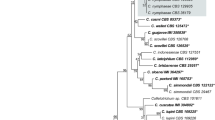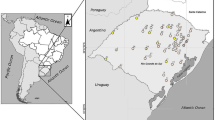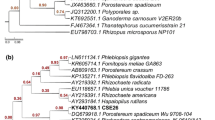Abstract
Sunflower is one of the most economically important oil crops. Recently, sunflower anthracnose caused by Colletotrichum destructivum was reported and suggested to be a potential threat to the quality of oil and edible seeds derived from sunflower in the field and even on the ornamentals in the residential gardens. Colletotrichum destructivum, as the causal agent of sunflower anthracnose, has been rarely studied. In this study, the vegetative growth and sporulation of this fungal species were investigated by assessing the requirements of nutrition and other environmental conditions, such as temperature, ambient pH, and lightness regime. Additionally, the sensitivity of C. destructivum to several fungicides was assessed. The results will provide a baseline for better understanding of the biology and etiology of C. destructivum. This study will be the first reference for a sustainable management strategy according to the occurrence and prevalence of the sunflower anthracnose.






Similar content being viewed by others
References
Baggio JS, Wang NY, Peres NA, Amorim L (2018) Baseline sensitivity of Colletotrichum acutatum isolates from Brazilian strawberry fields to azoxystrobin, difenoconazole, and thiophanate-methyl. Trop Plant Pathol 43:533–542
Balabanova D, Remans T, Vassilev A, Cuypers A, Vangronsveld J (2018) Possible involvement of glutathione S-transferases in imazamox detoxification in an imidazolinone-resistant sunflower hybrid. J Plant Physiol 221:62–65
Banerjee A, Islam S, Middya R (2017) Colletotrichum gloeosporioides causing leaf spot disease on Ixora coccinea in West Bengal. J Pharmacogn Phytochem 6:1730–1732
Bertetti D, Gullino ML, Garibaldi A (2009) Effect of leaf wetness duration, temperature and inoculum concentration on infection of evergreen Azalea by Colletotrichum acutatum, the causal agent of anthracnose. J Plant Pathol 91:763–766
Bordoy IEN, Quiroz FJ, Dosio GAA (2018) Increases in the source to sink ratio related to a higher carbohydrate concentration reduce phoma black stem in sunflower. Eur J Plant Pathol 150:623–637
Bousset L, Ermel M, Soglonou B, Husson O (2018) Fungal growth is affected by and affects pH and redox potential (Eh) of the growth medium. BioRxiv 2018:401182
Cannon PF, Damm U, Johnston PR, Weir BS (2012) Colletotrichum–current status and future directions. Stud Mycol 73:181–213
Carbone I, Kohn LM (1999) A method for designing primer sets for speciation studies in filamentous ascomycetes. Mycologia 91:553–556
Chen S, Wang Y, Schnabel G, Peng CA, Lagishetty S, SmithLuo KC, Yuan H (2018) Inherent resistance to 14α-demethylation inhibitor fungicides in Colletotrichum truncatum is likely linked to CYP51A and/or CYP51B gene variants. Phytopathology 108:1263–1275
Crouch JA, Beirn LA (2009) Anthracnose of cereals and grasses. Fungal Divers 39:19–44
Damm U, Cannon PF, Woudenberg JHC, Crous PW (2012) The Colletotrichum acutatum species complex. Stud Mycol 73:37–113
Damm U, O'Connell RJ, Groenewald JZ, Crous PW (2014) The Colletotrichum destructivum species complex–hemibiotrophic pathogens of forage and field crops. Stud Mycol 79:49–84
Dean R, Van Kan JAL, Pretorius ZA, Hammond-Kosack KE, Di Pietro A, Spanu PD et al (2012) The Top 10 fungal pathogens in molecular plant pathology. Mol Plant Pathol 13:414–430
De Souza Filho RC, da Silva Júnior TAF, Soman JM, Gonçalves RM, Chiorato AF, Ito MF et al (2015) Sensitivity of Colletotrichum lindemuthianum from green beans to fungicides and race determination of isolates from State of São Paulo, Brazil. Afric J Agri Res 10:2041–2047
FAOSTA (2018) Food and agriculture data. https://www.fao.org/faostat/. Accessed 28 May 2018
Freeman S (2008) Management, survival strategies, and host range of Colletotrichum acutatum on strawberry. HortScience 43:66–68
Gao YY, He LF, Li BX, Mu W, Lin J, Liu F (2017) Sensitivity of Colletotrichum acutatum to six fungicides and reduction in incidence and severity of chili anthracnose using pyraclostrobin. Aust Plant Pathol 46:521–528
Gao Y, He L, Mu W, Li B, Lin J, Liu F (2018) Assessment of the baseline sensitivity and resistance risk of Colletotrichum acutatum to fludioxonil. Eur J Plant Pathol 150:639–651
Glass NL, Donaldson GC (1995) Development of primer sets designed for use with the PCR to amplify conserved genes from filamentous ascomycetes. Appl Environ Microbiol 61:1323–1330
Han YC, Zeng XG, Xiang FY, Zhang QH, Cong G, Chen FY (2018) Carbendazim sensitivity in populations of Colletotrichum gloeosporioides, complex infecting strawberry and yams in Hubei province of China. J Integr Agr 17:1391–1400
Hyde KD, Cai L, Cannon PF, Crouch JA, Crous PW, Damm U et al (2009a) Colletotrichum-names in current use. Fungal Divers 39:147–182
Hyde KD, Cai L, McKenzie EHC, Yang YL, Zhang JZ, Prihastuti H (2009b) Colletotrichum: a catalogue of confusion. Fungal Divers 39:1–17
Jawalgekar PM, Mandge SV (2017) Effect of various carbon sources on the growth and sporulation of Colletotrichum Capsici. Bioinfolet-A Quarterly J Life Sci 14:372–374
Jawalgekar PM, Mandge SV (2018) Effect of various nitrogen sources on the growth and sporulation of Colletotrichum Capsici. Int J Recent Sci Res 9:23579–23580
Jayawardena RS, Hyde KD, Jeewon R, Li XH, Liu M, Yan JY (2016) Mycosphere essay 6: why is it important to correctly name Colletotrichum species? Mycosphere 7:1076–1092
Jeffries P, Dodd JC, Jeger MJ, Plumbley RA (1990) The biology and control of Colletotrichum species on tropical fruit crops. Plant Pathol 39:343–366
Joshi MS, Sawant DM, Gaikwad AP (2013) Variation in fungi toxicant sensitivity of Colletotrichum gloeosporioides isolates infecting fruit crops. ISABB J Food Agr Sci 3:6–8
Kumara KL, Rawal RD (2008) Influence of carbon, nitrogen, temperature and pH on the growth and sporulation of some Indian isolates of Colletotrichum gloeosporioides causing anthracnose disease of papaya (Carrica papaya L). Trop Agri Res Ext 11:7–12
Lamondia JA (2001) Management of euonymus anthracnose and fungicide resistance in Colletotrichum gloeosporioides by alternating or mixing fungicides. J Envir Hort 19:51–55
Liang Y, Xiong W, Steinkellner S, Feng J (2018) Deficiency of the melanin biosynthesis genes SCD1 and THR1 affects sclerotial development and vegetative growth, but not pathogenicity, in Sclerotinia sclerotiorum. Mol Plant Pathol 19:1444–1453
Liu JK, Chang HW, Liu Y, Qin Y, Ding YH et al (2018) The key gluconeogenic gene PCK1 is crucial for virulence of Botrytis cinerea via initiating its conidial germination and host penetration. Environ Microbiol 20:1794–1814
Luo Y, Wattanachai P, Soytong K (2015) Effect of different factors on sporulation of Colletotrichum coffeanum. Inter J Agri Tech 11:997–1012
Lv D, Zhang JY, Zhang Z, Zhou ZQ, Chen XK, Du XL, Qu SC (2012) The relationship between rDNA-ITS sequences and biological characteristics of the apple ring rot pathogen Botryosphaeria berengeriana de Not f. sp. piricola (Nose). Fungal Genom Biol 2:104
Mehetre PB, Joshi DM, Deshmukh HV (2010) Effect of various nitrogen sources on growth and sporulation of Colletotrichum capsici incitant of anthracnose of yam. Inter J Plant Protect 3:402–403
Miles TD, Gillett JM, Jarosz AM, Schilder AMC (2013) The effect of environmental factors on infection of blueberry fruit by Colletotrichum acutatum. Plant Pathol 62:1238–1247
Narkar SP, Sawant IS (2016) In vitro evaluation of carbendazim resistant Colletotrichum gloeosporioides isolates of grapes for sensitivity to QoI and DMI fungicides. Indian Phytopath 69:77–81
Saetae D, Suntornsuk W (2010) Antifungal activities of ethanolic extract from Jatropha curcas seed cake. J Microbiol Biotechnol 20:319–324
Sanders GM, Korsten L, Wehner FC (2000) Survey of fungicide sensitivity in Colletotrichum gloeosporioides from different avocado and mango production areas in South Africa. Eur J Plant Pathol 106:745–752
Sardhara MJ, Davara DK, Moradia AM, Kapadiya HJ (2016) Effect of culture media and temperature on growth and sporulation of Colletotrichum lindemuthianum of urdbean in vitro. Inter J Plant Protect 9:47–51
Satpathy MR, Beura SK, Mohanty RC (2012) Effect of nutrition on Colletotrichum lindemuthianum, the incitant of cowpea anthracnose. J Plant Protect Environ 9:60–62
Seiler GJ, Qi LL, Marek LF (2017) Utilization of sunflower crop wild relatives for cultivated sunflower improvement. Crop Sci 57:1083–1101
Shah FA, Wang CS, Butt TM (2005) Nutrition influences growth and virulence of the insect-pathogenic fungus Metarhizium anisopliae. FEMS Microbiol Lett 251:259–266
Sun HY, Liang Y (2018) First report of anthracnose on sunflower caused by Colletotrichum destructivum in China. Plant Dis 102:245
Tavares GM, Souza PED (2005) Effects of fungicides on the in vitro control of Colletotrichum gloeosporioides, the anthracnosis etiologic agent of the Papaya tree (Carica papaya L.). Ciên Agrotec 29:52–59
Templeton MD, Rikkerink EH, Solon SL, Crowhurst RN (1992) Cloning and molecular characterization of the glyceralde-hyde-3-phosphate dehydrogenase-encoding gene and cDNA from the plant pathogenic fungus Glomerella cingulata. Gene 122:225–230
Turechek WW, Peres NA, Werner NA (2006) Pre- and post-infection activity of pyraclostrobin for control of anthracnose fruit rot of strawberry caused by Colletotrichum acutatum. Plant Dis 90:862–868
Veloso JS, Câmara MP, Lima WG, Michereff SJ, Doyle VP (2018) Why species delimitation matters for fungal ecology: Colletotrichum diversity on wild and cultivated cashew in Brazil. Fungal Biol 122:677–691
Weir BS, Johnston PR, Damm U (2012) The Colletotrichum gloeosporioides species complex. Stud Mycol 73:115–180
White TJ, Bruns T, Lee SJWT, Taylor JL (1990) Amplification and direct sequencing of fungal ribosomal RNA genes for phylogenetics. In: Gelfand DH, Sninsky JJ, White TJ (eds) Innis MA PCR protocols: a guide to methods and applications. Academic Press, San Diego, pp 315–322
Yu SM, Ramkumar G, Lee YH (2013) Light quality influences the virulence and physiological responses of Colletotrichum acutatum causing anthracnose in pepper plants. J Appl Microbiol 115:509–516
Acknowledgements
This work is supported by LiaoNing Revitalization Talents Program (XLYC1807242), Fundamental Research Program for Liaoning Higher Education Institutions (LSNJC201914), and Scientific Research Foundation for the Introduced Talents of Shenyang Agricultural University (20153040).
Author information
Authors and Affiliations
Corresponding author
Ethics declarations
Conflict of interest
The authors declare they have no conflicts of interest.
Human and animal studies
The authors declare that ethical standards have been followed and that no human participants or animals were involved in this research.
Additional information
Communicated by Erko Stackebrandt.
Publisher's Note
Springer Nature remains neutral with regard to jurisdictional claims in published maps and institutional affiliations.
Rights and permissions
About this article
Cite this article
Sun, H., Tian, J., Steinkellner, S. et al. Identification and characterization of Colletotrichum destructivum causing anthracnose on sunflower. Arch Microbiol 202, 1459–1467 (2020). https://doi.org/10.1007/s00203-020-01861-8
Received:
Revised:
Accepted:
Published:
Issue Date:
DOI: https://doi.org/10.1007/s00203-020-01861-8




